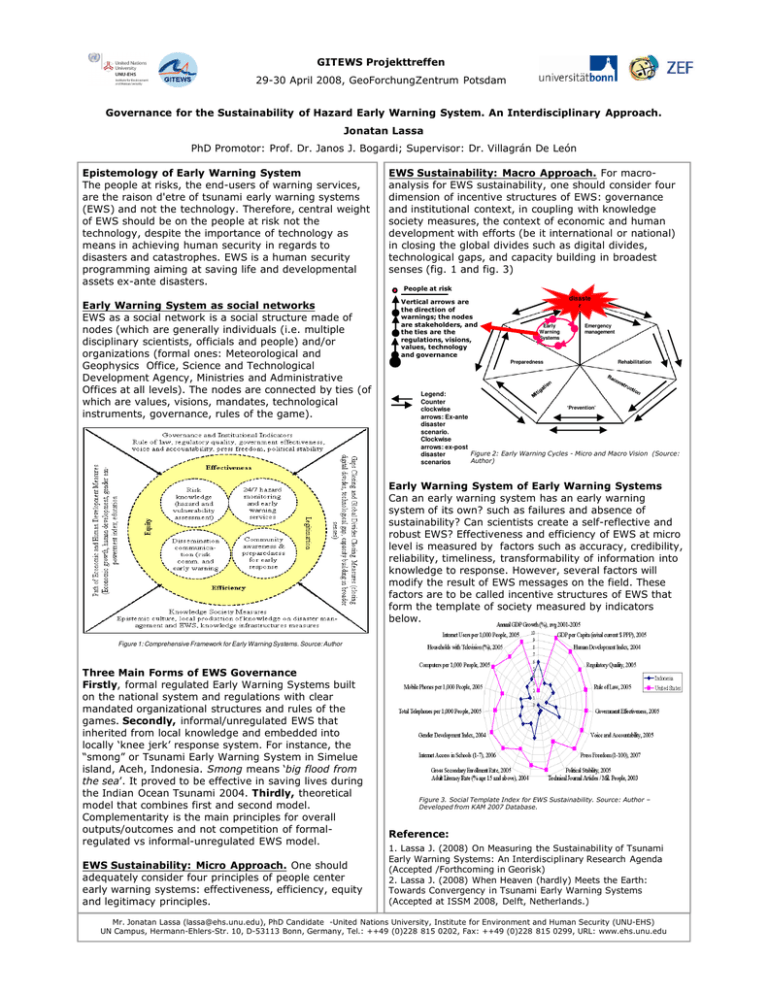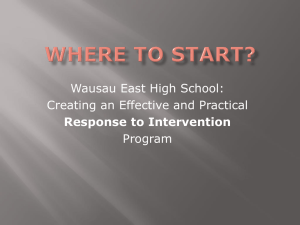Governance for the Sustainability of Hazard Early Warning System.... Jonatan Lassa
advertisement

GITEWS Projekttreffen 29-30 April 2008, GeoForchungZentrum Potsdam Governance for the Sustainability of Hazard Early Warning System. An Interdisciplinary Approach. Jonatan Lassa PhD Promotor: Prof. Dr. Janos J. Bogardi; Supervisor: Dr. Villagrán De León Epistemology of Early Warning System The people at risks, the end-users of warning services, are the raison d'etre of tsunami early warning systems (EWS) and not the technology. Therefore, central weight of EWS should be on the people at risk not the technology, despite the importance of technology as means in achieving human security in regards to disasters and catastrophes. EWS is a human security programming aiming at saving life and developmental assets ex-ante disasters. Early Warning System as social networks EWS as a social network is a social structure made of nodes (which are generally individuals (i.e. multiple disciplinary scientists, officials and people) and/or organizations (formal ones: Meteorological and Geophysics Office, Science and Technological Development Agency, Ministries and Administrative Offices at all levels). The nodes are connected by ties (of which are values, visions, mandates, technological instruments, governance, rules of the game). EWS Sustainability: Macro Approach. For macroanalysis for EWS sustainability, one should consider four dimension of incentive structures of EWS: governance and institutional context, in coupling with knowledge society measures, the context of economic and human development with efforts (be it international or national) in closing the global divides such as digital divides, technological gaps, and capacity building in broadest senses (fig. 1 and fig. 3) People at risk Vertical arrows are the direction of warnings; the nodes are stakeholders, and the ties are the regulations, visions, values, technology and governance disaste r Early Warning Systems Preparedness Emergency management Rehabilitation Legend: Counter ‘Prevention’ clockwise arrows: Ex-ante disaster scenario. Clockwise arrows: ex-post Figure 2: Early Warning Cycles - Micro and Macro Vision (Source: disaster Author) scenarios Early Warning System of Early Warning Systems Can an early warning system has an early warning system of its own? such as failures and absence of sustainability? Can scientists create a self-reflective and robust EWS? Effectiveness and efficiency of EWS at micro level is measured by factors such as accuracy, credibility, reliability, timeliness, transformability of information into knowledge to response. However, several factors will modify the result of EWS messages on the field. These factors are to be called incentive structures of EWS that form the template of society measured by indicators below. Figure 1: Comprehensive Framework for Early Warning Systems. Source: Author Three Main Forms of EWS Governance Firstly, formal regulated Early Warning Systems built on the national system and regulations with clear mandated organizational structures and rules of the games. Secondly, informal/unregulated EWS that inherited from local knowledge and embedded into locally ‘knee jerk’ response system. For instance, the “smong” or Tsunami Early Warning System in Simelue island, Aceh, Indonesia. Smong means ‘big flood from the sea’. It proved to be effective in saving lives during the Indian Ocean Tsunami 2004. Thirdly, theoretical model that combines first and second model. Complementarity is the main principles for overall outputs/outcomes and not competition of formalregulated vs informal-unregulated EWS model. EWS Sustainability: Micro Approach. One should adequately consider four principles of people center early warning systems: effectiveness, efficiency, equity and legitimacy principles. Figure 3. Social Template Index for EWS Sustainability. Source: Author – Developed from KAM 2007 Database. Reference: 1. Lassa J. (2008) On Measuring the Sustainability of Tsunami Early Warning Systems: An Interdisciplinary Research Agenda (Accepted /Forthcoming in Georisk) 2. Lassa J. (2008) When Heaven (hardly) Meets the Earth: Towards Convergency in Tsunami Early Warning Systems (Accepted at ISSM 2008, Delft, Netherlands.) Mr. Jonatan Lassa (lassa@ehs.unu.edu), PhD Candidate -United Nations University, Institute for Environment and Human Security (UNU-EHS) UN Campus, Hermann-Ehlers-Str. 10, D-53113 Bonn, Germany, Tel.: ++49 (0)228 815 0202, Fax: ++49 (0)228 815 0299, URL: www.ehs.unu.edu





